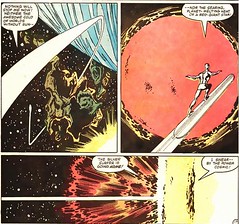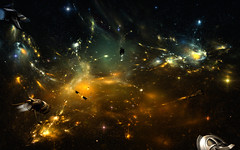Johnald's Fantastical Daily Link Splurge |
- NASA’s Contest to Design the Last Shuttle Patch
- Galactic Dwarf’s Stardust Shines in Infrared
- star [Flickr]
- baris-gurbuz-6 [Flickr]
- Ben-Hattenbach1_1383888i [Flickr]
- Akhmetsafin-Ruslan_1383897i [Flickr]
- Epic_by_casperium [Flickr]
| NASA’s Contest to Design the Last Shuttle Patch Posted: 06 Jan 2010 03:00 AM PST << previous image | next image >>  The space shuttle program is on its way out, but the core of people who built and maintained it will live on. To honor them, NASA gave its employees the chance to design the patch that will commemorate the shuttle program, which is slated to end in September, after STS-133 flies. From the designs of 85 current and former employees, the Shuttle Program Office has selected 15 finalists. The prospective patches, presented here, will be voted on internally by NASA employees and judged by a small panel.
"In 1976, the Space Shuttle program designed a patch, called the Space Shuttle Program logo, which was a single triangle, blue and white. It's very iconic," Pearlman said. "And the original idea was that since the space shuttle as of 1976 was going to fly so many times and so often — every couple weeks — you wouldn't want or need crew mission patches any longer. The idea was we'd do away with mission patches." But astronauts and other mission members dissented. By then, the patches had become a popular tradition within NASA, even though they'd only been used for a little more than a decade. In the wake of NASA's 1965 decision not to allow astronauts to name their own vehicles, one astronaut decided that his Gemini V mission needed a patch. His design, prominently featuring a covered wagon, became the first of hundreds of NASA patches. So, after some wrangling, NASA decided the shuttle missions could have their own patches after all. The first patch, for STS-1, was designed by Robert McCall, a well-known space artist, Pearlman said. Subsequent works have come together in a variety of ways. Some have been drawn by the astronauts themselves, others by hangers-on or friends. Together, they form an odd pictographic record of a program that has been at the center of the world's premiere space agency for more than 30 years. One of the 15 entries you see here will be the final installment in the series. In the patch design at the top of this post, the sunrise/sunset represents the start and finish of the shuttle program, and the stars honor the astronauts who died on Challenger and Columbia. The artist wrote, "I picked the most dramatic angle of the Shuttle I could find to highlight the magnificence of the most complicated space vehicle in the world." Captions are summaries of the artists' explanations. For full captions, go to CollectSpace.com. Images: NASA. | |||||||||||||||
| Galactic Dwarf’s Stardust Shines in Infrared Posted: 05 Jan 2010 11:40 AM PST
The Small Magellanic Cloud isn't much to look at with the naked eye, even for visitors to the International Space Station. Former astronaut John Grunsfeld told reporters Tuesday about a stargazing experience he had on the station. "At one point, I complained about a small greasy smudge on the window… That was the Small Magellanic Cloud," Grunsfeld, who was appointed deputy director of the Space Telescope Science Institute three days ago, said during a teleconference at the American Astronomical Society annual meeting. But now, Spitzer Space Telescope's incredible infrared camera has transformed the little smudge into a beautiful space photo. In the image above, old stars are blue while young stars are lighting up the dust around them green and red. The new images ofthis neighboring dwarf galaxy, which is located about 200,000 light-years away, are part of an effort to better understand the lifecycle of galaxies through tracking stardust. "We're tracing how a galaxy evolves through the dust," said Karl Gordon, an astrophysicist at the Space Telescope Science Institute, who is leading the effort to study the formation of the Small Magellanic Cloud. In the optical wavelengths, as Gordon noted, the Cloud is just "this kind of faint cloud, but in the infrared all the pieces of the galaxy come out." That's because infrared light has a longer wavelength than visible light. It can pass through dusty parts of the universe without being scattered. The upshot is that infrared astronomy lets scientists see through regions that would be nearly opaque to our eyes. "Observations in the infrared give us a view into the birthplace of stars, unveiling the dust-enshrouded locations where stars have just formed," Gordon said in a release. Image: NASA/JPL-Caltech/STScI. XXL 8.9 megabyte version. See Also:
WiSci 2.0: Alexis Madrigal's Twitter, Google Reader feed, and green tech history research site; Wired Science on Twitter and Facebook. | |||||||||||||||
| Posted: 08 May 2009 05:35 PM PDT johnald_chaffinch posted a photo: This posting includes an audio/video/photo media file: Download Now | |||||||||||||||
| Posted: 20 Apr 2009 11:32 PM PDT johnald_chaffinch posted a photo: This posting includes an audio/video/photo media file: Download Now | |||||||||||||||
| Ben-Hattenbach1_1383888i [Flickr] Posted: 17 Apr 2009 02:17 AM PDT johnald_chaffinch posted a photo: This posting includes an audio/video/photo media file: Download Now | |||||||||||||||
| Akhmetsafin-Ruslan_1383897i [Flickr] Posted: 17 Apr 2009 02:17 AM PDT johnald_chaffinch posted a photo: This posting includes an audio/video/photo media file: Download Now | |||||||||||||||
| Posted: 17 Apr 2009 02:17 AM PDT johnald_chaffinch posted a photo: This posting includes an audio/video/photo media file: Download Now |
| You are subscribed to email updates from Johnus Morphopalus's Facebook notes To stop receiving these emails, you may unsubscribe now. | Email delivery powered by Google |
| Google Inc., 20 West Kinzie, Chicago IL USA 60610 | |

 The program patch will help mark the end of the shuttle era. Begun rather enthusiastically in the late 1970s, the program almost didn't have mission patches, said
The program patch will help mark the end of the shuttle era. Begun rather enthusiastically in the late 1970s, the program almost didn't have mission patches, said 





